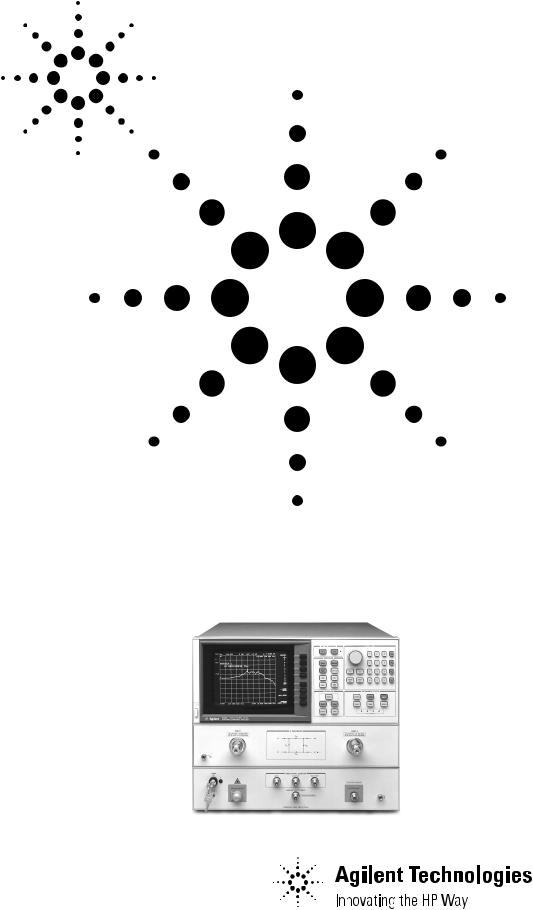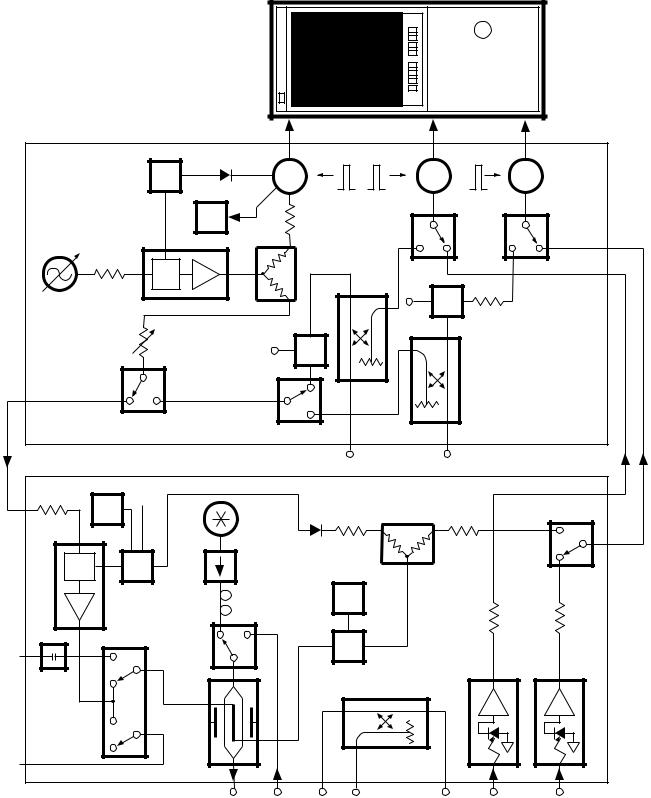Atec Agilent-8703A User Manual

Agilent 8703A
Lightwave Component Analyzer
Technical Specifications
1300 nm or 1550 nm carrier
130 MHz to 20 GHz modulation bandwidth
Single wavelength configuration

2
Introduction
A powerful combination of calibrated 20 GHz lightwave and microwave measurement capabilities is described in this Agilent 8703A technical specifications. This includes the following models and options:
Agilent 8703A Lightwave Component Analyzer
•Option 100 Adds External Lightwave Source Input
•Option 210 1550 nm DFB1 Laser
•Option 220 1300 nm DFB Laser
•Option 300 Adds One Lightwave Receiver
Agilent 83424A Lightwave CW Source
• Option 100 Adds External Lightwave Source Input
Agilent 83425A Lightwave CW Source
• Option 100 Adds External Lightwave Source Input
Table 1. Types of measurements performed with the Agilent 8703A
With accuracy, speed and convenience, the 8703A performs the optical, electrical, and electro-optical measurement types listed below. This data can be shown in magnitude, phase and distance-time measurement formats. A performance summary is in Table 2. Following Table 2 is a block diagram and detailed operating conditions and specifications.
Additional configuration information can be found in the 8703A configuration guide (Agilent literature number 5966-4827E).
1 “DFB” is an abbreviation for Distributed Feedback Laser.
Lightwave source characterization
(electrical-in and optical-out)
Source slope responsivity tests
•Modulation bandwidth
•Modulated output power flatness
•Step response
•Modulation signal group delay and differential phase
•Reflected signal sensitivity
•Distance-time response
Optical reflection tests
•Port return loss
•Distance-time response
Electrical reflection tests
•Port impedance or return loss
•Distance-time response
Lightwave receiver characterization
(optical-in and electrical-out)
Receiver slope responsivity tests
•Modulation bandwidth
•Modulated output power flatness
•Step response
•Modulation signal group delay and differential phase
•Distance-time response
Optical reflection tests
•Port return loss
•Distance-time response
Electrical reflection tests
•Port impedance or return loss
•Distance-time response
Optical device characterization
(optical-in and optical-out)
Optical transfer function tests
•Insertion loss or gain
•Modulated output power flatness
• Step response |
. |
•Modulation signal group delay and differential phase
•Distance-time response
•Modal dispersion
Optical reflection response tests
•Port return loss
•Distance-time response
Microwave device characterization
(electrical-in and electrical-out)
Electrical transfer function tests
•Insertion loss or gain
•Output power flatness
•Step response
•Group delay and deviation from linear phase
•Distance-time response
Electrical reflection response tests
•Port impedance or return loss
•Distance-time response

3
Agilent 8703A Performance overview
Table 2. Agilent 8703A performance overview2
System dynamic range..(see pages 5, 11, 14)
Transmission test (typical)
Optical-to-optical: 38 to 51 dBo
Optical-to-electrical: 105 to 110 dBe
Electrical-to-optical: 75 to 95 dBe
Electrical-to-electrical: 100 to 110 dBe
Reflection test (typical)
Optical: 31 to 44 dBo
Electrical: 36 to 56 dBe
Distance-time domain........... |
(see page 13) |
Length/location (typical)
Range: 10 ns to 0.5 ms (2 m to 50 km)
Range resolution: 0.5 ps (0.1 mm)
Response resolution: 24 to 48.5 ps (5 to 10 mm)
Stimulus types
Low pass step: 50 ps minimum rise time
Low pass impulse: 48.5 ps minimum pulse width Bandpass impulse: 97 ps minimum pulse width
Group delay |
|
measurements............................. |
(see page 15) |
Minimum aperture: 1 Hz
Maximum 1 Hz aperture delay: 500 ms
Lightwave source....................... (see page 6)
Wavelength: 1308 or 1550 nm, ±10 nm
Spectral width: 3 nm RMS (FP) or 50 MHz (DFB) (typical)
Average optical output power: 70 to 600 µW
Modulation bandwidth: 130 MHz to 20 GHz
Modulation frequency resolution: 1 Hz
Modulated optical output power (p-p): 90 to 130 µW (typical)
Modulation index: 25% (typical)
Optical return loss: 15 dBo (typical)
Lightwave receiver................... |
(see page 7) |
Wavelength: 1298 to 1560 nm
Input modulation bandwidth: 130 MHz to 20 GHz
Maximum average input power operating level:
5 mW
System sensitivity (typical): 20 nW
Input port return loss (typical): 20 dBo
Microwave source.................... |
(see page 11) |
Frequency bandwidth: 130 MHz to 20 GHz
Frequency resolution: 1 Hz
Output power range: +5 to –70 dBm
Harmonics: <–15 dBc (typical)
Microwave receiver................ |
(see page 11) |
Frequency bandwidth: 130 MHz to 20 GHz
Maximum input power operating level: 0 dBm
System sensitivity: –110 dBm
Connector types
Lightwave:
HMS-10
FC/PC
DIN 47256
ST
Biconic
SC
Microwave: 3.5 mm (male)
Data accuracy |
|
enhancement................................ |
(see page 15) |
Calibration types: |
|
Response calibration |
|
Response and match calibration |
|
Response and isolation calibration |
|
1-port calibration |
|
Full 2-port calibration |
|
Reference plane extensions |
|
Data averaging: |
|
IF bandwidth control |
|
Sweep-to-sweep averaging |
|
2Final performance depends upon the 8703A configuration. For example, performance will vary according to the type of lightwave source used. Refer inside for further information.

4
Agilent 8703A Block diagram
Figure 1. Simplified block diagrams for lightwave and microwave test sets and information processor
INFORMATION PROCESSOR
MICROWAVE TEST SET
ALC |
S |
S |
S Samplers |
|
Sampler Drive |
|
|
Phase |
|
|
Lock |
|
|
MOD |
|
0.13–20 GHz |
Bias |
|
Tee |
||
RF Source |
||
|
||
Step |
Bias |
|
Attenuator |
||
|
Tee |
LIGHTWAVE TEST SET |
|
|
RF Port 1 |
RF Port 2 |
|
External |
|
|
|
DAC |
Detector |
Laser |
|
|
|
|
|
||
|
|
1300 or |
|
|
|
|
1550 nm |
|
|
MOD |
ALC |
Isolator |
|
|
|
|
Polarization |
DAC |
|
|
|
Controller |
|
|
|
|
|
|
|
|
|
(Peak) |
|
|
|
Optical |
|
|
|
|
Switch |
|
Bias |
|
RF |
(Opt. 100 |
|
Tee |
Photodiode |
Input |
Only) |
|
|
|
DC |
|
|
Lightwave |
Receivers |
|
|
|
||
Block |
|
|
Directional Coupler |
|
|
Optical |
|
|
|
|
Modulator |
|
|
|
RF
Output
Optical |
External |
Input Coupled |
Test |
Auxiliary |
Optical |
Output |
Laser |
|
Port |
Optical |
Input |
|
Input |
|
|
Input |
|
|
(Opt. 100 Only) |
|
|
(Opt. 300 Only) |
|

5
Frequency domain lightwave dynamic range
Specifications describe the instrument’s warranted performance for the temperature range of 23 ±3°C after a three hour warm-up. Supplemental characteristics describe useful, non-warranted performance parameters. These are denoted as “typical” or “nominal”.
Measurement examples
The following graphs show device (DUT) measurements compared to typical (– – –) 8703A measurement ranges9.
Table 3. System dynamic range (typical)3
Frequency range (GHz)
|
|
0.13 to 12.0 |
12.0 to 20 |
|
Lightwave transfer function test |
|
|
|
|
Optical-to-optical4 |
43 dBo5 |
38 dBo |
||
Optical-to-electrical4 |
105 dBe6 |
105 dBe |
||
Electrical-to-optical |
85 dBe7 |
75 dBe |
||
Lightwave reflection test |
|
|
|
|
Optical4 |
36 dBo5 |
31 dBo |
||
|
|
|
|
|
|
|
|
|
|
|
|
|
Optical-to-optical |
|
Optical-to-electrical |
transmission test |
|
transfer function test |
(DUT = 10, 20, 30, 40 and |
|
(DUT = photodiode |
50 dB attenuators) |
|
receiver) |
Electrical-to-optical transfer function test (DUT = laser source)
3 |
Limited by maximum lightwave source output power, maximum |
5 |
For optical-to-optical devices, (dBo) = 10 log (#2 optical power |
|
lightwave receiver input power, maximum microwave output power |
6 |
(W p-p) / #1 optical power (W p-p)) |
|
and system noise floor. Specified for an IF bandwidth of 10 Hz and an |
For optical-to-electrical devices, slope responsivity (dBe) = 20 log |
|
|
averaging factor of 16 after an appropriate calibration has been |
7 |
((∆ current (A p-p) / ∆ optical power (W p-p)) / 1 A/W) |
|
performed (i.e. response & isolation calibration for optical tests, |
For electrical-to-optical devices, slope responsivity (dBe) = 20 log |
|
|
response & match and isolation calibration for electrical-to-optical |
8 |
((∆ optical power (W p-p) / ∆ current (A p-p)) / 1 W/A) |
4 |
and optical-to-electrical tests). |
Measurement range can be shifted upward by externally adding |
|
8703A Option 100 systems will typically see 1 dBo less dynamic range |
|
attenuation in the signal path during calibration and measurement. |
than is shown for optical transfer function and reflection measurements. Optical-to-electrical transfer function measurements will typically
see 2 dBe less.
